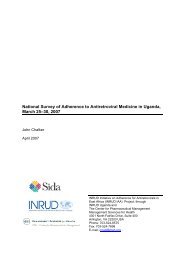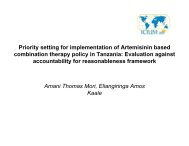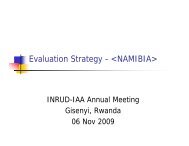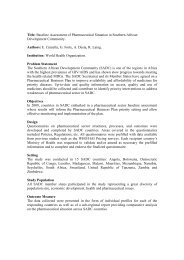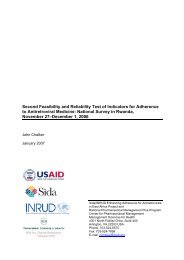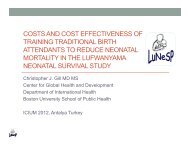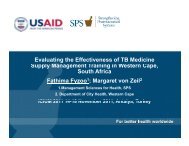How to investigate levels of Adherence to antiretroviral ... - INRUD
How to investigate levels of Adherence to antiretroviral ... - INRUD
How to investigate levels of Adherence to antiretroviral ... - INRUD
Create successful ePaper yourself
Turn your PDF publications into a flip-book with our unique Google optimized e-Paper software.
A.5<br />
APPENDIX 5 --- Complementary indica<strong>to</strong>rs <strong>of</strong><br />
adherence<br />
Pill count-based adherence measures<br />
Pill counts are used by some ART programmes <strong>to</strong> compare a patient’s actual and expected<br />
consumption since the pharmacy last dispensed the medicine. If records include pill counts,<br />
the data can be used <strong>to</strong> calculate the pill count adherence measures. Because pill count<br />
recording is relatively rare, these indica<strong>to</strong>rs are only collected where possible.<br />
Pill Count 1. Full adherence (pill count)—Percentage <strong>of</strong> patients with perfect recent<br />
adherence <strong>to</strong> ARV treatment<br />
Pill Count 2. Average adherence (pill count)—Average percentage <strong>of</strong> recent ARV doses<br />
taken<br />
Rationale<br />
Source <strong>of</strong> data<br />
Data collection<br />
Computation<br />
Comments and<br />
pitfalls<br />
Some programmes use pill counts <strong>to</strong> moni<strong>to</strong>r adherence. Pill counts at two<br />
consecutive visits can be used <strong>to</strong> estimate adherence between those two visits.<br />
Pill counts from clinical or pharmacy records.<br />
Based on record review <strong>of</strong> the same systematic sample <strong>of</strong> 100 patients used<br />
for the core adherence indica<strong>to</strong>rs.<br />
Data are needed on both the <strong>to</strong>tal number <strong>of</strong> pills taken home during the<br />
previous visit (including pills remaining in the bottle at that time plus newly<br />
dispensed pills that were added) and the number <strong>of</strong> pills remaining in the<br />
bottle brought <strong>to</strong> this visit.<br />
Consumption rate for each patient = (number <strong>of</strong> days <strong>of</strong> pills taken home in<br />
previous visit - number <strong>of</strong> days <strong>of</strong> pills remaining in bottle this visit)/(number<br />
<strong>of</strong> days that have elapsed since previous visit) × 100.<br />
Note: If any consumption rate is >100 percent, then change it <strong>to</strong> 100 percent.<br />
Full adherence—(Number <strong>of</strong> patients for whom consumption rate equals 100<br />
percent /number <strong>of</strong> patients with pill count data).<br />
Average adherence—(Sum <strong>of</strong> consumption rates across all patients/number <strong>of</strong><br />
patients with pill count data).<br />
Some patients dispose <strong>of</strong> medicines if they know that pill counts will be<br />
conducted at the clinic. Pill counts require considerable effort. If clinics already<br />
count pills, this method can provide alternate adherence measures. If a patient<br />
is taking > 1 ARV, these indica<strong>to</strong>rs should be calculated separately for each<br />
medication.<br />
Self report-based adherence measures from clinical or pharmacy<br />
records<br />
When collected from patient exit interviews, this is a core indica<strong>to</strong>r where the question and<br />
mode <strong>of</strong> asking has been standardized. Using clinical records <strong>to</strong> measure this indica<strong>to</strong>r is<br />
possible only if the question has been asked consistently and recorded routinely. For this<br />
reason the self report written in clinical notes is a complementary adherence indica<strong>to</strong>r. In<br />
141



